In the fast-paced world of financial trading, knowledge is indeed power. One key concept that every trader needs to understand, novice or seasoned, is slippage. It’s a fundamental aspect of trading that can significantly impact your profit and loss calculations, and consequently, your trading strategies and decisions.
Slippage, in the context of trading, is the difference between the expected price of a trade and the price at which the trade is actually executed. This concept might sound straightforward, but in real-world trading, it’s a far more nuanced phenomenon. Slippage can occur during both rising and falling markets and is a common occurrence in volatile markets or when a large order is placed and there isn’t enough volume at the chosen price to maintain the current bid/ask spread.
As traders, understanding slippage can help navigate the inherent uncertainties that exist within the market dynamics. Recognizing its implications can mean the difference between a successful trading strategy and one that falls short of its profit targets. By taking a deep dive into this topic, we aim to equip traders with the knowledge they need to more accurately forecast their trades and mitigate potential risks associated with market fluctuations.
In the following sections, we’ll demystify the concept of slippage, explore its causes and effects, and discuss effective strategies to manage and minimize its impact on your trading portfolio. Whether you’re just getting started in trading or are looking to refine your approach, comprehending slippage is an essential step on the path to trading success.
What is slippage in Trading?
lippage in trading refers to the difference between the expected price of a trade and the price at which the trade actually gets executed. This discrepancy is a fairly common occurrence in financial markets and can happen for a number of reasons.
For instance, let’s say you’re trading stocks and you place a market order to buy a particular stock at $50. If the order is filled at $51, you’ve experienced slippage of $1.

Slippage can occur due to several factors such as sudden changes in market prices caused by news events or economic data releases, the time it takes for a broker to execute an order, and the lack of liquidity — which is often an issue with thinly traded securities.
It’s important to note that slippage isn’t always negative. It can also result in a better-than-expected execution price. For example, if you place a limit order to sell a stock at $30 and it gets filled at $31, you’ve experienced positive slippage.
Understanding slippage is important for traders as it can affect the profitability of trades, especially for those who engage in high-frequency trading or other strategies that depend on executing trades at precise price levels.
Why Slippage is Important When Day Trading?
Day trading is a prime example of a trading approach where calculating slippage is paramount to minimizing risk and maintaining profitability.
Day traders typically engage in high-frequency trading, making numerous trades within a single trading day with the aim of profiting from small price movements. Due to the rapid pace of this style of trading and the small profit margins on individual trades, even minor deviations from expected trade prices can have significant impacts on a day trader’s bottom line.
Consider this example:
A day trader intends to make hundreds of trades on a particular stock in a day. The trader uses a trading algorithm which is set to buy the stock whenever its price dips to $50, expecting to sell it when the price rebounds to $50.05 – a profit of $0.05 per share.
However, due to market volatility and the large volume of orders being processed, the orders don’t get filled at exactly $50. Instead, they’re filled at $50.02 on average. This discrepancy of $0.02 is the slippage.
While $0.02 may not sound like much, in the world of high-frequency trading, it’s substantial. If the trader is buying 1000 shares with each order, that’s an extra cost of $20 per trade. Over hundreds of trades, this can add up to a significant loss.
By calculating and keeping track of this slippage, the trader can adjust their trading strategy accordingly. For example, they might adjust their algorithm to buy at $49.98 instead of $50 to account for the average slippage. Alternatively, they might choose to trade a different stock with less volatility and lower average slippage.
In this way, understanding and accounting for slippage is essential for successful and risk-managed day trading.
Conclusion
Understanding slippage and how it can influence trade outcomes is a crucial aspect of successful trading, regardless of the market or trading strategy. By keeping a close eye on slippage and taking steps to minimize it when possible, traders can better manage risk, improve the accuracy of their trade executions, and increase the likelihood of achieving their profit targets.
Below is a summary table that provides an overview of when it’s especially important to consider slippage:
| Trading Scenario | Importance of Calculating Slippage |
|---|---|
| Day Trading | High – Many trades with thin profit margins mean slippage can significantly affect profitability. |
| Trading during Volatile Markets | High – Rapid price changes can cause significant slippage. |
| Trading Illiquid Assets | High – Lack of liquidity can cause orders to be filled at prices significantly different from the expected. |
| Swing Trading / Long-term Investing | Moderate to Low – Slippage can still affect trade outcomes, but the impact on profitability is generally smaller due to larger profit margins and fewer trades. |
| Trading Highly Liquid Assets in Stable Markets | Low – Prices are unlikely to change significantly between placing and executing a trade. |
Remember, slippage isn’t inherently bad – it’s simply a feature of financial markets. The goal isn’t to eliminate slippage, but to understand it and incorporate it into your trading strategy. By doing so, you’ll be better prepared to navigate the complexities of the trading world and achieve your trading objectives.
